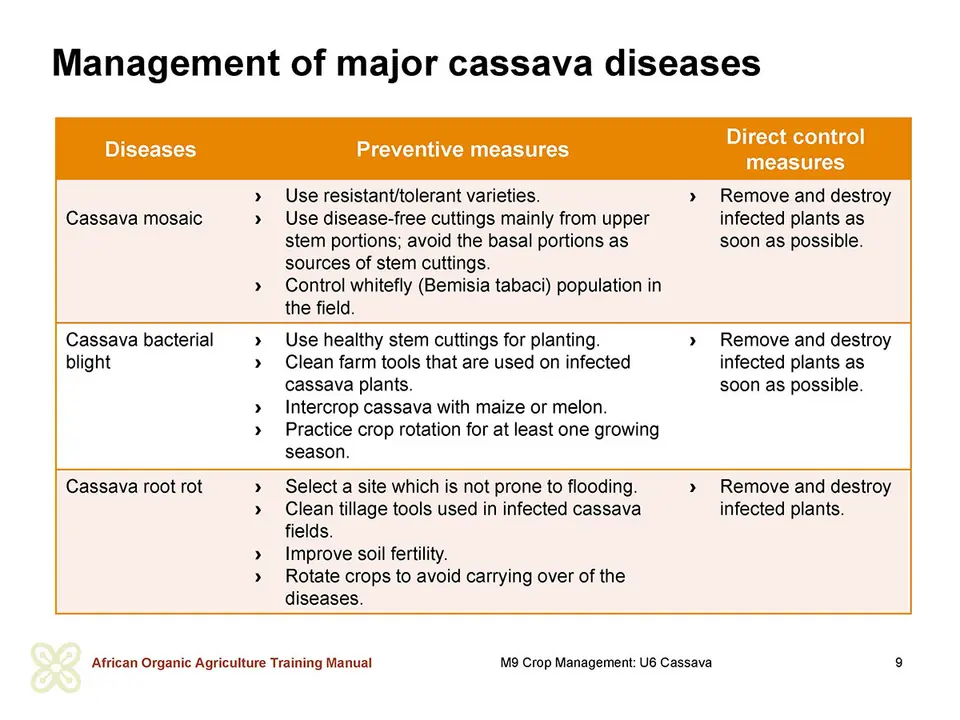Effective disease management
The main diseases affecting cassava can be divided into two groups: leaf and stem diseases and stem and root diseases. However, the major diseases in sub-Saharan Africa are cassava mosaic disease, cassava bacterial blight, cassava anthracnose disease and root rot.
Leaf and stem diseases:
- Cassava leaf mosaic disease causes yield reductions of up to 90 %. It is caused by the African cassava mosaic virus which occurs inside the leaves and stems. The symptoms are discoloured leaves with patches of normal green colour mixed with light green, yellow, and white area (chlorosis). The symptoms are more pronounced on younger plants, usually under 6 months, than older plants. The disease is spread through infected cuttings and by whiteflies (Bemisia tabaci).
- Cassava bacterial blight (Xanthomonas campestris pv. manihotis) is caused by a bacterium which occurs inside cassava leaves and stems. Damage appears as water-soaked dead spots. The lesions occur between leaf veins and are most evident on the lower surfaces of the leaves. The symptoms are more evident in the wet than in the dry season and the disease is more severe in young plants than in older ones. The disease is mainly spread through infected cuttings and can cause yield losses of 20 to 100 %.
Stem and root diseases:
- Cassava brown streak disease is transmitted by whiteflies through infected cuttings. Symptoms of damage appear on the leaves (yellow patches), stems (dark brown streaks), and tubers of cassava plants (cracks and discoloration).
- Cassava root rot diseases are caused by various kinds of fungi living on or in the soil. The fungi occur mainly in poorly drained soils. The leaves on cassava plants affected by root rot disease turn brown, wilt, and the plant appears scorched. The disease kills both feeder and storage roots of cassava. The affected storage roots have an unusual smell and develop light brown colouration.
Recommendations for farmers for effective disease management:
The best way to control diseases is to grow a healthy cassava crop and avoid infestation by preventing the introduction of disease pathogens. This can be achieved by combining plant production and protection strategies. The strategies include the following recommendations:
- Practise appropriate crop rotation, intercropping and improving soil fertility through application of well-decomposed organic manures. For example, intercropping cassava with maize and melon can reduce cassava bacterial blight significantly. Rotation and fallowing should last at least one growing season.
- Plant disease free cuttings from healthy plants without leaf chlorosis, shoot tip die-back, cankers, fungus patches, or streaks on the stems. Where possible, grow cassava varieties that are tolerant or resistant to the common cassava diseases in the local area. For example, cassava varieties resistant to cassava mosaic disease are commonly available in Africa.
- Improve the growing conditions by improving soil fertility (through manuring) in order to encourage cassava plants to grow vigorously and offset damage by cassava diseases. Timely planting especially at the beginning of the rainy season is also important to promote proper establishment and good growth of the cassava plants. Improving soil drainage will also reduce the incidence of root rot.
Remove infested cassava plants from the field as soon as possible. After root harvest, destroy discarded cassava stems and tubers showing any symptom of disease. Clean farm tools that are used to cut infested cassava plants immediately after use. This reduces the spread of diseases from damaged areas to healthy cassava crops.

 tap and then scroll down to the Add to Home Screen command.
tap and then scroll down to the Add to Home Screen command.